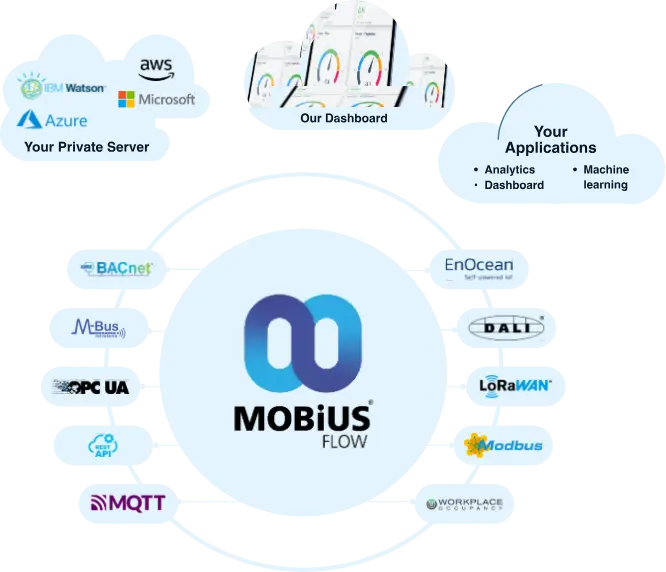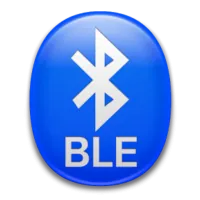Trusted by 500+ happy customers
Streamlined IoT Data Management
MobiusFlow is an enterprise IoT platform that unites protocols, sensors, and systems – from EnOcean to Azure, from legacy equipment to modern IoT devices – into one powerful data management solution.

“MobiusFlow delivers significant operational and financial benefits by unlocking stranded data at a fraction of the usual cost and time.”
Iain Warner, IRW Engineering Ltd

Expertise in data integration
Up and running in hours, not months.
One platform managing all your connected systems
Keeping your operations running without interruption
End-to-End IoT Platform
Seamlessly connect sensors, cloud, and applications—effortless IoT integration in just a few clicks.
Hardware
Sensors
Control Devices
Gateways
External Data Sources
Connect your IoT Ecosystem
Support for your equipment profiles and protocols, from edge devices to cloud platforms.
Normalized Data

Device Drivers
Process data your way
Convert any data format into standardized streams ready for analysis and automation.
Applications
Dashboards
Data Visualisation Analytics
Control
Machine Learning
APIs
Build Smart Workflows
Create custom rules and automated responses using our advanced processing engine.

Born from real-world challenges
Making Complex Systems Simple Since 2004
While commissioning devices in a new building project in 2013, our CTO Chris found himself perched on a paint tin, laptop in hand, wrestling with multiple systems and protocols. The process was slow, complex, and inefficient – a common problem across the industry.
That frustration led to MobiusFlow. What began as an internal tool to simplify device commissioning and remote control has evolved into a comprehensive IoT product. Now, it helps system integrators and solution providers worldwide connect complex systems, process data, and automate operations more efficiently than ever.
The complete MobiusFlow Toolkit
Each component is designed to work independently or together, allowing you to choose one or all to build and customise your ideal IoT ecosystem.


MobiusFlow Engine
Process data from any source into standardized formats. Connect legacy systems, IoT sensors, and cloud platforms into one unified data stream. Includes Flows, which allow you to create powerful, real-time data processing and automation.
Features:

MobiusFlow View
Create dynamic dashboards that display your normalized data in real-time. Build custom visualisations that matter to your operations.
Features:

MobiusFlow Toolbox
An advanced engineering tool that allows users to easily and powerfully work with the MobiusFlow Engine and Flows. Toolbox enables complex data analysis and automation, turning data into actionable insights and automated decisions.
Features:

MobiusFlow Manager
Your central command center for project deployment and monitoring. Deploy and manage all your MobiusFlow installations from a single interface.
Features:
From raw data to working intelligence
How MobiusFlow transforms raw, stranded and disparate IoT data into a unified and efficient solution.
One system, many data sources
Setting up IoT networks is complex – multiple protocols, different data formats, and diverse hardware requirements eat up time and resources.
MobiusFlow standardises everything through built-in device drivers and protocol support, enabling fast deployment and clean data flow between edge devices and cloud services.


Securing your solutions
As IoT networks expand, security vulnerabilities multiply. Poor integration creates risk.
Smart IoT systems need robust security protocols and standardized integration methods. Proprietary solutions often create more problems than they solve.
MobiusFlow protects your data ecosystem with enterprise-grade security – including multi-factor authentication, public key infrastructure, and secure API gateways. Security that grows with your system.
Flexible deployment options
MobiusFlow lets you choose how to handle your data. Deploy in the cloud, on your own infrastructure, or create a hybrid solution that fits your exact needs.


Industrial IoT across Sectors
A platform built to handle the demands of any industry or application.
MobiusFlow works across industrial automation, manufacturing, healthcare, retail, energy systems, and more. Our flexible architecture handles both standard protocols and custom implementations.
Why choose MobiusFlow?
Compelling reasons to use our platform.
Future-ready
Built to scale and adapt as your systems grow
Quick results
Up and running in hours, not months—accelerate your deployment and realizing value faster
Reliable & secure
Enterprise-grade security with proven uptime
Customizable
Adapt the platform to fit your specific needs
White label capability
Embed MobiusFlow into your own branded solution
Protocol-Agnostic Integration
Support for your equipment profiles and major IoT protocols – from EnOcean and LoRaWAN to MQTT and Azure. Connect any device, any system, anywhere.
Flexible Deployment
Run MobiusFlow in the cloud or on-premise to meet your security and operational needs.
Advanced Rules Engine
Create complex automation workflows using our visual builder. From simple device triggers to multi-step processes, build logic that matches your needs.
Protocol-Agnostic Integration
Support for your equipment profiles and major IoT protocols – from EnOcean and LoRaWAN to MQTT and Azure. Connect any device, any system, anywhere.
Data Processing Engine
Pull data from multiple sources into one standardized format. Process edge data, create automated workflows, and enable two-way communication between systems.
Flexible Deployment
Deploy how you need it – cloud, on-premises, or hybrid. Scale from single sites to global operations without changing your architecture.
Enterprise Security
Built for industrial IoT security. Multi-factor authentication, public key infrastructure, and secure API gateways protect your entire data ecosystem.
Customizable Solution
White-label the entire platform or specific components. Add your brand and customise features without compromising functionality.
What MobiusFlow Clients say
Real feedback from businesses transforming their operations.
FAQ
Can’t see the answer you need?
Ready to Build Your IoT Solution?
Get your complex systems working together.
From industrial automation to smart buildings, MobiusFlow helps you connect any protocol, any system, any scale. Whether you’re managing a single facility or a global network, our platform brings your IoT data into one powerful system.














